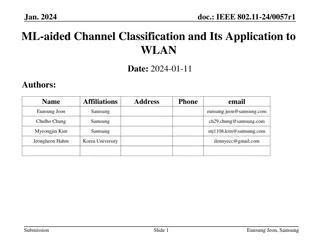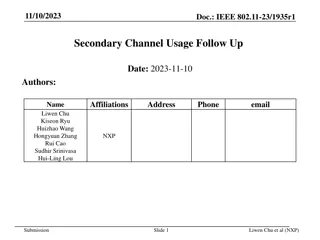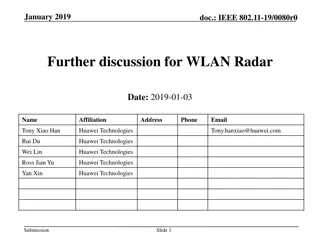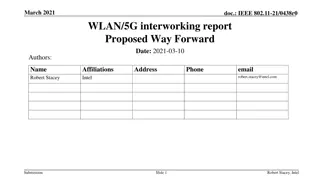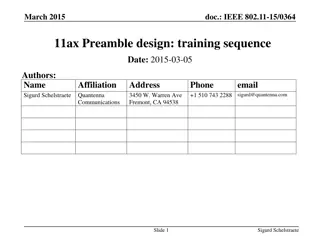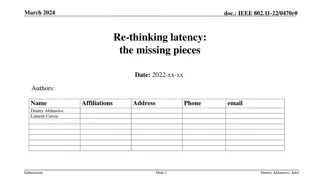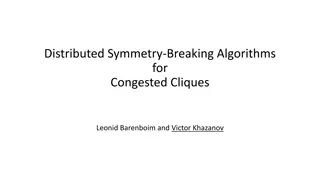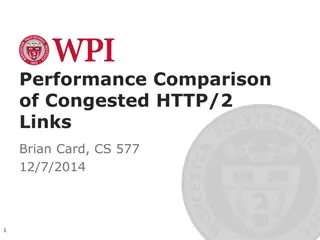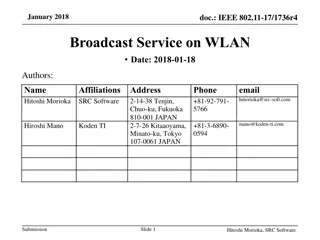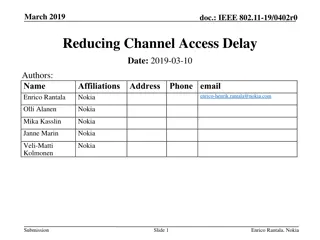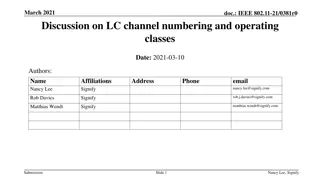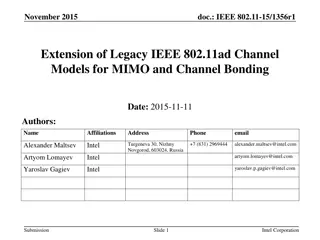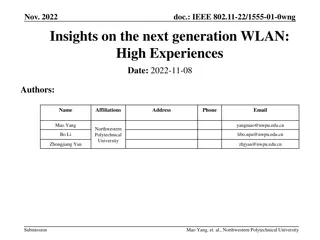
Issue of Congested Primary Channel in IEEE 802.11 WLAN - Solutions and Challenges
Explore the challenges posed by congested primary channels in IEEE 802.11 WLAN networks and discover potential solutions to enhance system capacity and efficiency. Learn about the impact of channel congestion on data transmission and the need for agile strategies to overcome these hurdles.
Uploaded on | 2 Views
Download Presentation

Please find below an Image/Link to download the presentation.
The content on the website is provided AS IS for your information and personal use only. It may not be sold, licensed, or shared on other websites without obtaining consent from the author. If you encounter any issues during the download, it is possible that the publisher has removed the file from their server.
You are allowed to download the files provided on this website for personal or commercial use, subject to the condition that they are used lawfully. All files are the property of their respective owners.
The content on the website is provided AS IS for your information and personal use only. It may not be sold, licensed, or shared on other websites without obtaining consent from the author.
E N D
Presentation Transcript
January 2017 Issue of Congested Primary Channel in 802.11 WLAN doc.: IEEE 802.11-17/0129r2 Date: 2017-01-16 Authors: Name Kauto Yano Affiliations Address Advanced Telecommunica tions Research Institute International (ATR) Phone email kzyano@atr.jp jwebber@atr.jp Julian Webber tsukamoto@atr.jp Satoshi Tsukamoto Naoto Egashira egashira.naoto@atr.jp t.kumagai@atr.jp Tomoaki Kumagai Submission Slide 1 Kazuto Yano, ATR
January 2017 doc.: IEEE 802.11-17/0129r2 Abstract This presentation: raises an issue of current IEEE 802.11 wireless LAN when the primary channel is congested, shows a possible way to overcome this issue. Submission Slide 2 Kazuto Yano, ATR
January 2017 doc.: IEEE 802.11-17/0129r2 Background IEEE 802.11 wireless LAN has been widely and densely deployed, and now it still needs to enhance its system capacity to accommodate a large amount of various traffic including very-large size file transfer, real-time application, and M2M/IoT application. If the amount of traffic in a BSS increases, the channel used by the BSS becomes congested. Moreover, IEEE 802.11 wireless LAN is sometimes exposed to interference from OBSS and/or other wireless system such as non-802.11 system (and LAA in future). The amount of arrival interference will vary dynamically, and it may cause instantaneous heavy congestion. Submission Slide 3 Kazuto Yano, ATR
January 2017 Issue of congested primary channel on current IEEE 802.11 wireless LAN doc.: IEEE 802.11-17/0129r2 However, a BSS sets one primary channel on which each STA invokes the back-off procedure to transmit its data [1]. If the primary channel is congested, the STA hardly transmits its data even if other channels are vacant [2]. Since radio resources are limited, it is important to flexibly utilize temporal vacant channels to improve effective system capacity. Another STA cannot transmit its data if the primary channel is busy. busy idle idle idle idle idle ch. a ch. b ch. c ch. d ch. e ch. f primary channel Submission Slide 4 Kazuto Yano, ATR
January 2017 Issue of congested primary channel on current IEEE 802.11 wireless LAN (cont.) doc.: IEEE 802.11-17/0129r2 A BSS can change its primary channel to increase available radio resources by using the procedure of DFS or FST in several TBTTs. However, it is not agile so as to: efficiently utilize temporal vacant channels, provide enough QoS, especially for real-time data traffic. Another STA cannot transmit its data if the primary channel is busy. busy idle idle idle idle idle ch. a ch. b ch. c ch. d ch. e ch. f primary channel Submission Slide 5 Kazuto Yano, ATR
January 2017 doc.: IEEE 802.11-17/0129r2 To overcome this issue One or more vacant channels may continuously or temporarily exist in the same frequency band with the primary channel or in another frequency band. If a STA can instantly obtain transmission opportunity from such vacant channels even when the primary channel is congested, the amount of available radio resource and effective system capacity would be increased. Available radio resources will be increased if transmission opportunity can be obtained from another channel. busy idle idle idle idle idle ch. a ch. b ch. c ch. d ch. e ch. f primary channel Submission Slide 6 Kazuto Yano, ATR
January 2017 doc.: IEEE 802.11-17/0129r2 Summary In IEEE 802.11 wireless LAN, a BSS sets one primary channel on which each STA invokes the back-off procedure If the primary channel is congested, the STA hardly transmits its data even if other channels are vacant. This issue would be overcome if a STA could quickly obtain enough transmission opportunity from such a vacant channel. This would lead to increase the amount of available radio resources and effective system capacity. Submission Slide 7 Kazuto Yano, ATR
January 2017 doc.: IEEE 802.11-17/0129r2 Straw Poll Do you think that IEEE 802.11 wireless LAN should have a new way to overcome the situation that the primary channel is heavily congested? Y: N: A: Submission Slide 8 Kazuto Yano, ATR
January 2017 doc.: IEEE 802.11-17/0129r2 References [1] IEEE 802.11-2012. [2] doc. IEEE 802.11-14/1473r1. Submission Slide 9 Kazuto Yano, ATR



